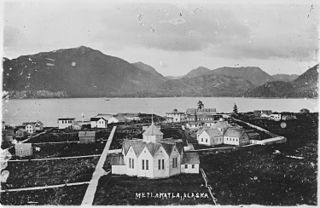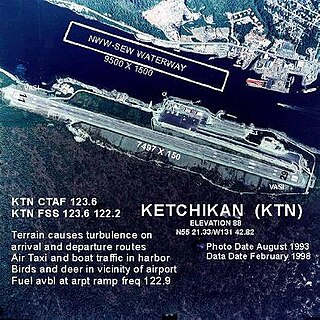
Southeast Alaska, sometimes referred to as the Alaska Panhandle, is the southeastern portion of the U.S. state of Alaska, bordered to the east by the northern half of the Canadian province of British Columbia. The majority of Southeast Alaska's area is part of the Tongass National Forest, the United States' largest national forest. In many places, the international border runs along the crest of the Boundary Ranges of the Coast Mountains. The region is noted for its scenery and mild rainy climate.

The City and Borough of Juneau, commonly known as Juneau, is the capital city of Alaska. It is a unified municipality on Gastineau Channel in the Alaskan panhandle, and it is the second largest city in the United States by area. Juneau has been the capital of Alaska since 1906, when the government of what was the District of Alaska was moved from Sitka as dictated by the U.S. Congress in 1900. The municipality unified on July 1, 1970, when the city of Juneau merged with the city of Douglas and the surrounding Greater Juneau Borough to form the current municipality, which is larger by area than both Rhode Island and Delaware.

Ketchikan Gateway Borough is a borough located in the U.S. state of Alaska. As of the 2010 census, the population was 13,477. The borough seat is Ketchikan.

Prince of Wales–Hyder Census Area is a census area located in the U.S. state of Alaska. As of the 2010 census, the population was 5,559. It is part of the unorganized borough and therefore has no borough seat. Its largest communities are Craig and Metlakatla. It was formerly part of the Census Bureau's Prince of Wales–Outer Ketchikan Census Area, but the name was changed in 2008 after most of the Outer Ketchikan was lost to annexation by the Ketchikan Gateway Borough.

Saxman is a city on Revillagigedo Island in Ketchikan Gateway Borough in southeastern Alaska, United States. At the 2010 census the population was 411, down from 431 in 2000. The city of Ketchikan lies just to its northwest.

Metlakatla is a census-designated place (CDP) on Annette Island in Prince of Wales-Hyder Census Area, Alaska, United States. At the 2000 census the population was 1,375; this had grown to 1,405 by the 2010 census.

Mendenhall Glacier is a glacier about 13.6 miles (21.9 km) long located in Mendenhall Valley, about 12 miles (19 km) from downtown Juneau in the southeast area of the U.S. state of Alaska. The glacier and surrounding landscape is protected as part of the 5,815 acres (2,353 ha) Mendenhall Glacier Recreation Area, a federally designated unit of the Tongass National Forest.

Ketchikan International Airport is a state-owned, public-use airport located one nautical mile (2 km) west of the central business district of Ketchikan, a city in Ketchikan Gateway Borough in Alaska that has no direct road access to the outside world or to the airport. The airport is located on Gravina Island, just west of Ketchikan on the other side of the Tongass Narrows. Passengers must take a seven-minute ferry ride across the water to get to the airport from the town.

Ward Cove is an unincorporated community in Ketchikan Gateway Borough, Alaska, United States. Its elevation is 164 feet (50 m). Although it is unincorporated, it has a post office, with the ZIP code of 99928.
Cape Fox Village is a locality in Southeast Alaska near present-day Ketchikan. It is the site of a former village called Gaash of the Cape Fox people of the Tlingit. The location of the village is on the east side of Revillagigedo Channel, four miles south of Boca de Quadra. The name was recorded in 1880 by Ivan Petroff during the 10th Census, who reported 100 Tlingit still living there. Many native artifacts were taken from this area during early American and European exploration of Alaska, and many of these items have since been returned, including a totem pole that had been on display at Field Museum in Chicago.
The Gravina Island Highway is a 3.2-mile-long (5.1 km) gravel highway located on Gravina Island, in the Ketchikan Gateway Borough of the U.S. state of Alaska. The highway was part of a project that would connect Gravina Island, specifically, the Ketchikan International Airport, to the city of Ketchikan. The Gravina Island Bridge, which would have connected the highway to Ketchikan was cancelled, but the highway was built. Because the highway does not pass by or connect to any village or other place of importance, it has been nicknamed the Highway to Nowhere.

Loring was established in 1885 with the first post office in the District of Alaska and is a census-designated place (CDP) in Ketchikan Gateway Borough in the U.S. state of Alaska. The population was 4 at the 2010 census, although the number increases in summer months.
George Inlet is a bay in the U.S. state of Alaska. It is situated within the Alexander Archipelago at the southern shore of Revillagigedo Island. It was named by the U.S. National Geodetic Survey in 1880 after pilot W. E. George, who created the first sketch of Revillagigedo Channel and Tongass Narrows.
Ward Cove is a bay in the U.S. state of Alaska. It is situated about 5 miles (8.0 km) to the westward of Ketchikan off the western coast of Revillagigedo Island within the Alexander Archipelago. The town of Ward Cove is located on the waterway. It is a small bay on the northern shore of Tongass Narrows. Ward Cove Stream empties into the head of the cove, and is the outlet to a chain of lakes. It flows in a fairly straight course in a southerly direction over rocky bottom, with a rapid current throughout its length, between high bluff banks well wooded. Tide water extends a short distance within the mouth. The stream water is fairly clear. It is about .75 miles (1.21 km) long, and 300 feet (91 m) below the lake, has a width of 20 feet (6.1 m) and a depth of 0.75 feet (0.23 m), and a 3-knot current.

Ketchikan Creek is a waterway on Revillagigedo Island in the U.S. state of Alaska. It heads in a lake and travels 6 miles (9.7 km) to Tongass Narrows. The historic Creek Street in Ketchikan runs along the creek banks as a piling-perched boardwalk.


















